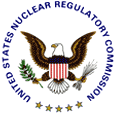| Search Options | ||||
| Index | Site Map | FAQ | Facility Info | Reading Rm | New | Help | Glossary | Contact Us | ||||

| Home > Electronic Reading Room > Document Collections > News Releases > 2006 > 06-026 |
|||||||||
 |
|
||||||||
| No. 06-026 | February 17, 2006 | ||||||||
NRC ISSUES REPORT FOR COMMENT ON SPENT NUCLEAR FUEL |
|||||||||
| The Nuclear Regulatory Commission is seeking public comment on a study of how a truck cask for transporting spent nuclear fuel might perform in a severe tunnel fire.
The report models the performance of the NAC International Model LWT (NAC) spent fuel cask under the conditions of the April 1982 fire in the Caldecott highway tunnel near Oakland, Calif., when a gasoline tanker carrying 8,800 gallons of gasoline overturned and caught fire. Severe, intense fires such as the Caldecott fire are extremely rare. However, they provide an opportunity to study how transportation packages might perform under very severe accident conditions. The results of this study strongly indicate that any radioactive release from the NAC model or a similar spent fuel shipping cask involved in a severe tunnel fire such as that of the Caldecott highway tunnel accident would be within regulatory limits. The peak internal temperatures predicted for the NAC cask in the analysis of the Caldecott fire scenario were not high enough to result in rupture of the fuel cladding (protective metal tubing around the fuel). Therefore, it would not be expected that any radioactive material (including spent nuclear fuel particles or fission products) would be released from the fuel rods. The maximum cask temperatures experienced around the lid, vent and drain ports exceeded the seals’ rated service temperatures, making it possible that the seals might degrade. In this event, there is a very small chance that some surface contamination might fall off the fuel rods and escape through the degraded seals. However, the cask design limits the potential releases so that they are within the regulatory limits. Last September, the NRC released for public comment a similar report modeling the July 2001 Baltimore rail tunnel fire. The study modeled the performance of two rail casks and the NAC truck cask in a severe tunnel fire. The report concluded that potential releases from any of these casks under such conditions would be within regulatory limits. The Baltimore tunnel fire report (NUREG/CR 6886) is available at
http://www.nrc.gov/reading-rm/doc-collections/nuregs/contract/cr6886/cr6886.pdf The Caldecott study "Spent Fuel Transportation Package Response to the Caldecott Tunnel Fire Study Scenario" (NUREG/CR 6894) is available on-line at http://www.nrc.gov/reading-rm/doc-collections/nuregs/docs4comment.html or http://www.nrc.gov/reading-rm/adams.html. From this site, you can access the NRC's Agencywide Document Access and Management System (ADAMS), and enter accession number ML060330028. If you do not have access to ADAMS or if you have problems in accessing the document in ADAMS, contact the NRC Public Document Room (PDR) Reference staff at 1-800-397-4209, 301-415-4737, or by email to pdr@nrc.gov. Comments and questions on the Caldecott report can be entered on-line or directed to Allen Hansen at agh@nrc.gov or (301) 415-1390, (301) 415-8555 (fax), by May 30, 2006. Comments received after this date will be considered if it is practical to do so, but assurance of consideration cannot be given to comments received after this date. |
|||||||||
|
Privacy Policy |
Site Disclaimer |